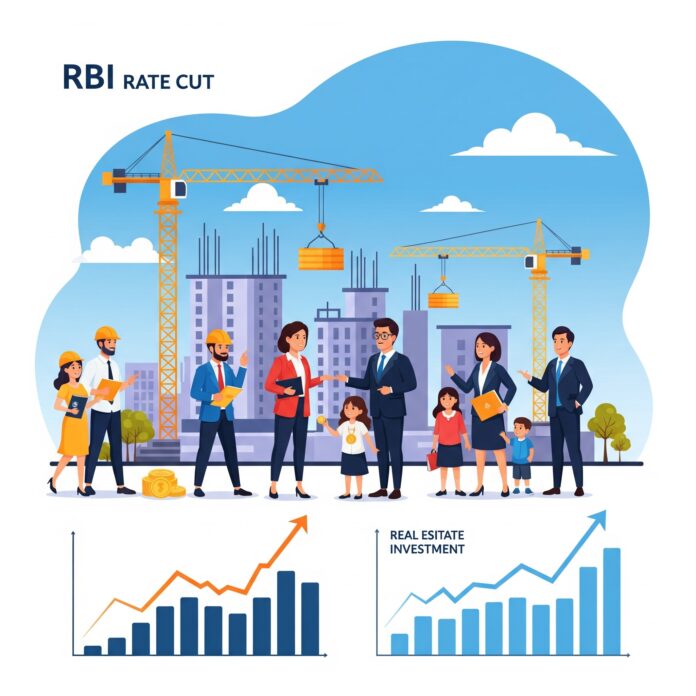NEW DELHI – In a highly anticipated move, the Reserve Bank of India (RBI) has delivered a significant boost to the nation’s economy and its crucial real estate sector with a substantial cut in its benchmark policy interest rate. This reduction, reportedly a 50 basis point cut in the repo rate, announced following the Monetary Policy Committee (MPC) meeting, is being universally welcomed by industry titans as a pivotal decision designed to rejuvenate demand, enhance affordability, and unleash a new wave of construction and investment across residential and commercial properties.
This rate cut is being lauded as a “timely and well-calibrated response to the prevailing macroeconomic environment,” especially one “marked by contained inflation and stable liquidity”. Industry experts assert that this proactive approach by the central bank reinforces its “strong commitment to supporting growth amid ongoing global headwinds”.
Unlocking Homeownership: Reduced EMIs and Bolstered Sentiment
The most immediate and impactful consequence of this monetary easing is expected to be a significant reduction in home loan equated monthly installments (EMIs). This translates directly into enhanced affordability, making homeownership a more viable dream for a broader spectrum of society, particularly within the mid-income and affordable housing segments.
Prateek Tiwari, MD of Prateek Group, expressed confidence that “The move will inject greater confidence in the already booming housing segment, as lower interest rates will significantly reduce the cost of borrowing”. Mayank Jain, CEO of KREEVA, underscored that this reduced borrowing cost “will not only strengthen homebuyers’ sentiments but also help in easing the liquidity flow in the market”.
The impact extends beyond sentiment. Dhruv Agarwala, Group CEO, Housing & Proptiger, highlighted that in housing, “where affordability is critical, especially in the budget segment, a reduction in interest rates will go a long way in sustaining demand”. Piyush Bothra, co-founder and CFO, Square Yards, articulated the sentiment perfectly, calling the 50-bps reduction “the right dosage which was required to unleash the animal spirits,” promising “meaningful EMI savings” that improve affordability for homebuyers. Furthermore, the improved affordability and positive market sentiment are expected to “spur investments and accelerate momentum across the sector”. Dhaval Ajmera, secretary of CREDAI-MCHI, specifically noted that the cut would “improve loan eligibility and affordability for lower-income households,” unlocking “latent demand in the affordable housing segment, which he termed the ‘backbone of India’s residential market'”. This could drive “an increase in residential property enquiries and conversions, and a pickup in sales volumes across key urban markets”.
Catalyst for Development: New Launches and Robust Growth
The rate cut is also a significant boon for developers, providing “much-needed relief to sectors under pressure”. Lower borrowing costs for developers will “ease capital costs… potentially reigniting momentum in price-sensitive markets”. This encourages them to “come up with new launches, sustaining the market’s growth”.
Anurag Mathur, CEO of Savills India, affirmed that developers would “benefit from eased financial burdens, which could lead to an acceleration in new construction projects, thereby enhancing new launches”. The reduced interest rates will also “encourage developers to take on new projects, boosting construction activity and creating employment opportunities”. Murali Malayappan, CMD of Shriram Properties, highlighted the combined effect of the rate cut and the CRR cut (unlocking ₹2.5 lakh crore in liquidity), which he stated “will strengthen capital flows and project execution,” positioning developers “to pass on these savings and accelerate demand-led growth”. Kamal Khetan, CMD of Sunteck Realty, added that stronger banking liquidity could help developers “execute projects faster,” creating a “dual win for buyers and builders”. Shishir Baijal, chairman and managing director, Knight Frank India, expressed hope that “the developer community too renews its focus in a big way to give longer legs to this housing market upcycle which is in its 5th year”.
Broader Economic Catalysis: Liquidity, Investment, and GDP
The RBI’s move is far more than just a real estate stimulus; it’s a strategic intervention to bolster the broader Indian economy. Nesara BS, chairman of Concorde, projected a palpable positive impact on India’s GDP, suggesting a growth trajectory from 6.5% to 7%. Anshuman Magazine, chairman & CEO – India, South-East Asia, Middle East & Africa, CBRE, emphasized the “significant move that will have a positive impact on the economy and various sectors, including real estate,” leading to “lower borrowing costs, increased liquidity, and enhanced consumer spending power”.
The central bank has transitioned its policy stance from ‘Accommodative’ to ‘Neutral,’ indicating a careful observation of the global scenario to act accordingly. Major commercial banks are now expected to “pass on this benefit to homebuyers and developers by lowering interest rates, stimulating real estate demand and investments”. Rohit Gera, managing director of Gera Developments, confirmed that “these measures are designed to accelerate monetary policy transmission and bring down lending rates across the board,” directly aiming to “bolster domestic economic growth and shared prosperity amid global uncertainties” and revive “private investment and consumption”. Vimal Nadar, national director & head, Research, Colliers India, affirmed that the move is a “strong tailwind” that will “boost homebuyer confidence, and enhance affordability, especially in the affordable and mid-income housing segments”. He also pointed to a medium-term impact of reduced cost of capital in enhancing investor confidence.
This bold and proactive step underscores the central bank’s commitment to “stimulating economic growth and maintaining adequate liquidity in the system”. As Rakesh Reddy, director, Aparna Constructions, noted, while the repo rate below 6% is a “moment of celebration,” the crucial next step is to “monitor and facilitate the effective transmission of these benefits to both consumers and developers on time”, ensuring the intended impact is fully realized and a new wave of homeownership drives broader economic participation and market growth.

